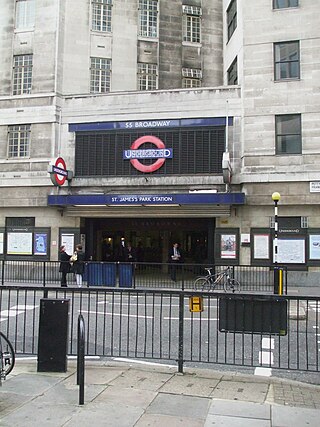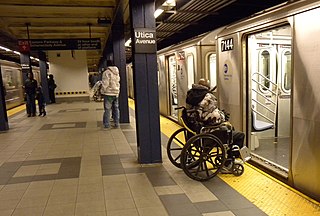Related Research Articles

Accessibility is the design of products, devices, services, vehicles, or environments so as to be usable by people with disabilities. The concept of accessible design and practice of accessible developments ensures both "direct access" and "indirect access" meaning compatibility with a person's assistive technology.

St James's Park is a London Underground station near St James's Park in the City of Westminster, England. It is served by the Circle and District lines between Victoria and Westminster stations, and is located in Travelcard Zone 1.

Armadale railway station is a commuter railway station in Armadale, a suburb of Melbourne, Victoria, Australia. The station is listed on the Victorian Heritage Register and was opened on 7 May 1879. The station consists of an island platform and two side platforms, all accessed by a pedestrian bridge. There are two principal station buildings located on the central platform and on platform 4, consisting of a small two and one-story brick buildings. These buildings were provided in 1914 as ticketing and staff offices. The station is only partially accessible due to a multiple steep access ramps.

Buses have been used as a mode of public transport in London since 1829, when George Shillibeer started operating a horse-drawn omnibus service from Paddington to the City of London. In the decades since their introduction, the red London bus has become a symbol of the city. In 2019, buses accounted for 11 per cent of trips taken in the city.

Melbourne tram route 96 is operated by Yarra Trams on the Melbourne tram network from East Brunswick to St Kilda Beach. The 13.9 kilometre route is operated out of Southbank and Preston depots with C2 and E class trams.

Melbourne tram route 75 is operated by Yarra Trams on the Melbourne tram network from Vermont South to Central Pier. The 22.8 kilometre route is operated out of Camberwell depot with A and B class trams. It is the longest route on the network.

A low-floor bus is a bus or trolleybus that has no steps between the ground and the floor of the bus at one or more entrances, and low floor for part or all of the passenger cabin. A bus with a partial low floor may also be referred to as a low-entry bus or seldom a flat-floor bus in some locations.

The London Transit Commission (LTC) is responsible for the operation of the public transit system on behalf of the City of London, Ontario, Canada. It operates transit bus service and para-transit service. In 2014, annual ridership totaled 24.1 million. The LTC has 28 regular bus routes, six express routes, three school-year-only routes and six community bus routes.

London has an extensive and developed transport network which includes both public and private services. Journeys made on its integrated transport network account for 37% of London's journeys while private services accounted for 36% of journeys, walking 24% and cycling 2%, according to numbers from 2017. London's public transport network serves as the central hub for the United Kingdom in rail, air and road transport.
Accessibility for people with disabilities on the Toronto Transit Commission (TTC) system is incomplete but improving. Most of the Toronto subway system was built before wheelchair access was a requirement under the Ontarians with Disabilities Act (ODA). However, all subway stations built since 1996 are equipped with elevators, and elevators have been installed in 45 stations built before 1996. Over three-quarters of Toronto's subway stations are accessible. The original plan was to make all stations accessible by 2025; however, a few stations might not be accessible until 2026.

The Dennis Lance was a single-decker bus chassis manufactured by Dennis between 1991 and 2000, replacing the Dennis Falcon. Its low floor variant, the Dennis Lance SLF was built between 1993 and 1996. Between 1995 and 1998, Dennis also built its double-deck variant, the Dennis Arrow, as the replacement of the Dennis Dominator.

London Buses route 507 was a Transport for London contracted bus route in London, England. It ran between Waterloo station and Victoria bus station, and was operated by Go-Ahead London.

London Buses route 205 is a Transport for London contracted bus route in London, England. Running between Bow Church and Paddington, it is operated by Stagecoach London.

London Buses route 120 is a Transport for London contracted bus route in London, England. Running between Northolt station and Hounslow bus station, it is operated by Metroline.
The Disabled Persons Railcard is a concessionary fare scheme in the United Kingdom giving eligible passengers with disabilities benefits on the National Rail network including a 1/3 discount on fares.

Metrobus is a high frequency, high capacity bus network in Sydney, Australia, first introduced in 2008. Metrobus services run every 10 minutes during peak periods, 15 minutes during off-peak weekday periods, and 20 minutes on weekends, linking key commercial suburbs and centres throughout the city, with the intention of making timetables obsolete. All buses were initially painted in a distinctive red livery but recently, the standard Transport for NSW livery of blue and white has been adopted. All Metrobus services are wheelchair accessible. All route numbers were prefixed with an "M" followed by a two-digit number.

High-floor describes the interior flooring of commuter vehicles primarily used in public transport such as trains, light rail cars and other rail vehicles, along with buses and trolleybuses. Interior floor height is generally measured above the street surface or above the top of the rail. High-floor designs usually result from packaging requirements: mechanical items such as axles, motors, crankshafts, and/or transmissions, or luggage storage spaces are traditionally placed under the interior floor of these vehicles. The term is used in contrast with low-floor designs, which offer a decreased floor and entry height above the street surface. Since low-floor designs generally were developed after high-floor vehicles, the older high-floor design is sometimes also known as conventional or the “traditional” design.

The physical accessibility of the Metropolitan Transportation Authority (MTA)'s public transit network, serving the New York metropolitan area, is incomplete. Although all buses are wheelchair-accessible in compliance with the Americans with Disabilities Act of 1990 (ADA), much of the MTA's rail system was built before wheelchair access was a requirement under the ADA. This includes the MTA's rapid transit systems, the New York City Subway and Staten Island Railway, and its commuter rail services, the Long Island Rail Road (LIRR) and Metro-North Railroad. Consequently, most stations were not designed to be accessible to people with disabilities, and many MTA facilities lack accessible announcements, signs, tactile components, and other features.

The accessibility of public transport services in Greater London is incomplete. Much of the rail network in London was built before accessibility was a requirement. Unlike in the United States, Underground stations built in the 1960s and 1970s made no provision for the disabled, with wheelchair users banned from deep level Underground lines until 1993.

London Buses route SL1 is a Transport for London contracted Superloop express bus route in London, England. Running between North Finchley and Walthamstow bus stations, it is operated by Arriva London.
References
- ↑ "Stationlink makes connection". LT News. 28 January 1993. p. 5.
- ↑ Brown, Stewart J (September 1993). Buses in Britain. Capital Transport. p. 159. ISBN 1-85414-158-9.
- ↑ "Catch the bus link". Westminster and Pimlico News. 27 January 1993. p. 4.
- 1 2 Neilan, Terence (1994-03-20). "Q and A". The New York Times. ISSN 0362-4331 . Retrieved 2021-08-26.
a single-decker bus service called Stationlink, which is also wheelchair accessible and operates on a clockwise circular route that connects all the London railway stations
- ↑ "Stationlink bus service expands". The Croydon Post. 10 July 1996. p. 12.
- ↑ "Stationlink doubles services". Evening Standard. 23 July 1996. p. 55.
- ↑ Marius, Callum (2022-02-19). "Every London bus route that has randomly changed numbers since 2000 and why". MyLondon. Retrieved 2022-02-20.
- ↑ "Transport for London wins Independent Living Award". Transport for London. 14 December 2007. Retrieved 2021-08-10.
We have the biggest wheelchair accessible bus network in the world